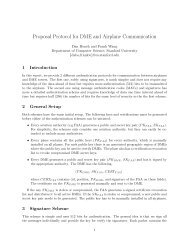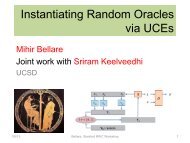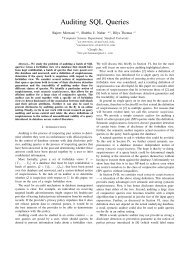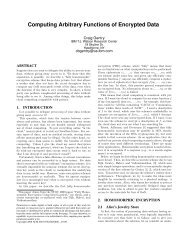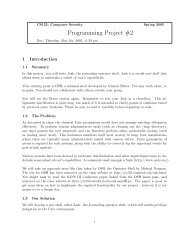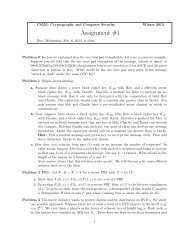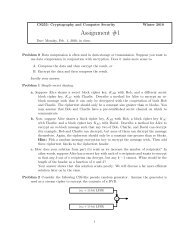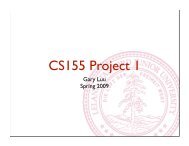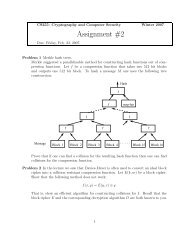Assignment #3 - Applied Crypto Group at Stanford University
Assignment #3 - Applied Crypto Group at Stanford University
Assignment #3 - Applied Crypto Group at Stanford University
Create successful ePaper yourself
Turn your PDF publications into a flip-book with our unique Google optimized e-Paper software.
Open: To open the commitment Alice sends (x, r) to Bob. Bob verifies th<strong>at</strong><br />
b = g x · h r mod p.<br />
Show th<strong>at</strong> this scheme is secure and binding.<br />
a. To prove security show th<strong>at</strong> b does not reveal any inform<strong>at</strong>ion to Bob about x. In<br />
other words, show th<strong>at</strong> given b, the committed value can be any integer x ′ in<br />
[0, q − 1].<br />
Hint: show th<strong>at</strong> for any x ′ there exists a unique r ′ ∈ [0, q − 1] so th<strong>at</strong> b = g x′<br />
h r′<br />
.<br />
b. To prove the binding property show th<strong>at</strong> if Alice can open the commitment as<br />
(x ′ , r ′ ) where x = x ′ then Alice can compute the discrete log of h base g. In other<br />
words, show th<strong>at</strong> if Alice can find an (x ′ , r ′ ) such th<strong>at</strong> b = gx′ hr′ mod p then she<br />
can find the discrete log of h base g. Recall th<strong>at</strong> Alice also knows the (x, r) used<br />
to cre<strong>at</strong>e b.<br />
Problem 4. (incremental hashing) Let p be a prime and let g ∈ Z ∗ p be an element of prime<br />
order q. We let G denote the group gener<strong>at</strong>ed by g and we let I denote the set of integers<br />
{1, . . . , q}. Fix n values g1, . . . , gn ∈ G and define the hash function H : I n → G by<br />
H(x1, . . . , xn) = g x1<br />
1 g x2<br />
2 · · · g xn<br />
n<br />
a. Show th<strong>at</strong> H is collision resistant assuming discrete-log in G is intractable. Th<strong>at</strong> is,<br />
show th<strong>at</strong> an <strong>at</strong>tacker capable of finding a collision for H for a random g1, . . . , gn ∈<br />
G can be used to compute discrete-log in G.<br />
Hint: given a pair g, h ∈ G your goal is to find an α ∈ Z such th<strong>at</strong> g α = h. Choose<br />
g1, . . . , gn ∈ G so th<strong>at</strong> a collision on the resulting H will reveal α.<br />
b. Let M be a message in I n . Suppose user Alice already computed the hash of M,<br />
namely H(m). Now, Alice changes only one coordin<strong>at</strong>e of M to obtain a new<br />
message M ′ . Show th<strong>at</strong> Alice can quickly compute H(M ′ ) from H(M) in time<br />
th<strong>at</strong> is independent of the length of M.<br />
You have just shown th<strong>at</strong> after making a small change to a message there is no<br />
need to rehash the entire message. Collision resistant hash functions of this type<br />
are said to support incremental hashing.<br />
Problem 5 Let’s explore why in the RSA public key system each person has to be assigned<br />
a different modulus N = pq. Suppose we try to use the same modulus N = pq for<br />
everyone. Each person is assigned a public exponent ei and a priv<strong>at</strong>e exponent di such<br />
th<strong>at</strong> ei · di = 1 mod ϕ(N). At first this appears to work fine: to encrypt a message<br />
to Bob, Alice computes C = M ebob and sends C to Bob. An eavesdropper Eve, not<br />
knowing dbob appears to be unable to decrypt C. Let’s show th<strong>at</strong> using eeve and deve<br />
Eve can very easily decrypt C.<br />
a. Show th<strong>at</strong> given eeve and deve Eve can obtain a multiple of ϕ(N).<br />
b. Show th<strong>at</strong> given an integer K which is a multiple of ϕ(N) Eve can factor the<br />
modulus N. Deduce th<strong>at</strong> Eve can decrypt any RSA ciphertext encrypted using<br />
the modulus N intended for Alice or Bob.<br />
2



